Following the launch of The National Archives’ new online exhibition ‘To Her Most Excellent Majesty’ showcasing congratulatory addresses from Queen Victoria’s Golden and Diamond Jubilees, I’d like to share my experience of working on this project.

Working on a PP 1 record
I’m a Digitisation Support Conservator in the Commercial Delivery Department which means I carry out conservation work that is needed to prepare documents for scanning. In October 2010 I was asked to survey the condition of the documents in the PP 1 series: Privy Purse Office, Jubilee Addresses to Queen Victoria.
This series includes 666 pieces, 89 of which were previously unknown and were discovered during my survey! The pieces are mostly scrolls or folded parchments with stunning illuminations in gold leaf and bright pigments from the 19th century.
To carry out the survey I had to open and go through each box where, in most cases, there were three or four scrolls, individually wrapped with their own label and sometimes housed in leather or textile cases. I then had to check the physical condition of each of the documents. The amazing aspect of surveying such a varied collection was that every time I opened a box, I found the most spectacular objects inside. There were illuminated scrolls with wooden rollers, presentation books with wax seals, detailed photo albums, gold tooled leather cases and varied materials such as silk, velvet, metal, wood, paper and silver.
The result of having such a heterogeneous (varied) collection is that the physical condition of the materials is also different. Taking into account the fact that the collection was to be photographed, I found the most frequent problem to be the flaking of the pigments used to decorate some of parchments and the scrolls.
There are various reasons why pigments flake, crack or powder; but in the PP 1 series it is largely caused by the handling of the object – the action of rolling and unrolling or folding and unfolding the parchments. These actions can cause stress on the actual parchment material itself and consequently on the pigments. The result is they don’t stay attached to their surface and they tend to lift up. In this case the most successful conservation treatment used is consolidation. Consolidation means applying a small amount of adhesive to strengthen the bond between the parchment and the pigment.
This procedure was needed for PP 1/41/2 ‘Women Subjects and Servants’ in the UK. While surveying the record, I noticed that this beautiful object needed extra care because the pigments were badly cracking and flaking and without intervention they would have detached completely. With the help of a microscope, a small brush and some adhesive (in this case an adhesive called Isinglass, which is made from the dried swim bladders of fish) the consolidation of the pigments was very successful and after the treatment the scroll has been re-housed flat in storage to reduce future handling stress.

Women Subjects and Servants in the UK (PP 1/42/2)

The online PP1 exhibition is quite stunning and this account of the preparatory work by the Conservator is all the more interesting as a result. Thank you for this excellent insight!
What beautiful art work. It was so very interesting hearing from the conservator about the process of ensuring these absolute jewels survive.
Thank you for sharing these beautiful things and the wonderful work behind the scenes.
Wonderful. I regret I can’t see this incredible collection. Congratulations. I live in Uruguay.